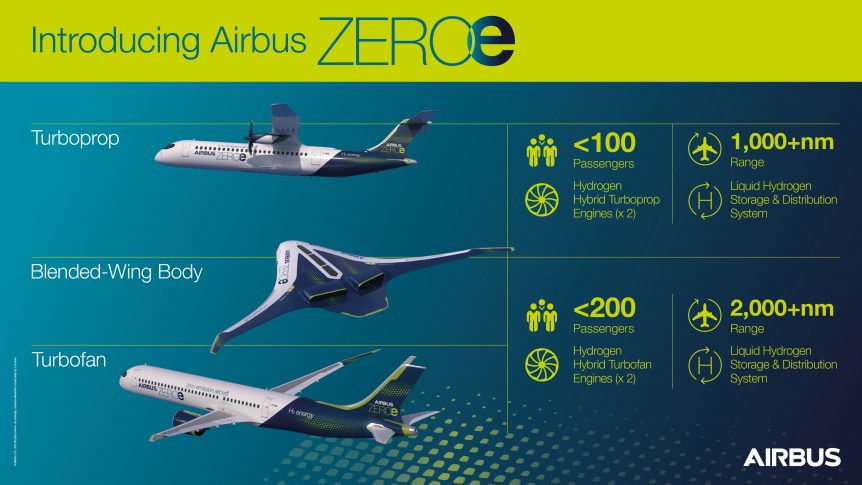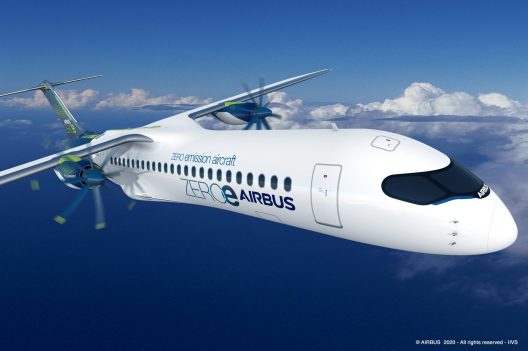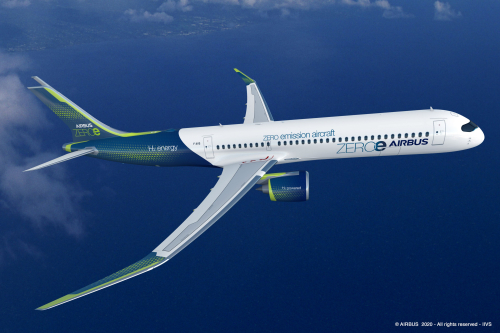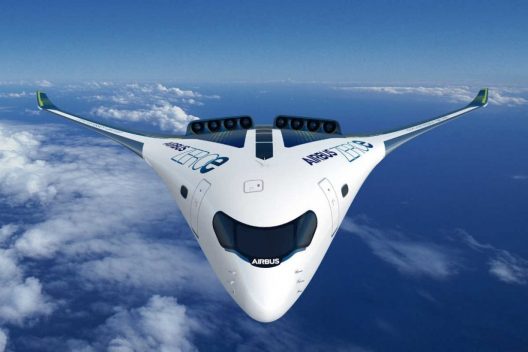ZEROe
Airbus, taking a new direction, announced that they are, “Exploring game-changing concept aircraft – known as ZEROe – powered by hydrogen, a disruptive zero-emission technology with the potential to reduce aircraft emissions by up to 50%.”
Two seem to be evolutionary, employing a different fuel and powertrain within fairly conventional airframes. The third, a blended-wing body (BWB) structure, emulates Boeing’s and NASA’s BWB. All three, though, employ hydrogen to meet the planet’s need to reduce or eliminate carbon dioxide and other emissions. All three use hydrogen hybrid power systems.
The International Civil Aviation Organization (ICAO) in a 2019 report looked at the different electric and hybrid systems available. The organization included a factor examined before in this blog. “The climate benefits of electric aviation may come not only from its reduced CO2 emissions, but also from the elimination of contrails – the long, thin clouds that form in the wake of jet engines2. Although no scientific consensus exists on the radiative forcing effect of contrails, some studies point out that they may have further warming impacts on the global climate.”
To counter the effects of CO2 emissions and radiative forcing, Airbus employs a different type of hybridization in their ZEROe craft. “This means they are powered by modified gas turbine engines that burn liquid hydrogen as fuel. At the same time, they also use hydrogen fuel cells to create electrical power that complements the gas turbine, resulting in a highly efficient hybrid-electric propulsion system. However, each option has a slightly different approach to integrating the liquid hydrogen storage and distribution system.”
By 2035
Airbus promises to bring the first of these aircraft to flight by 2035, noting a sense of déjà vu for two of the designs. The jet airliner sporting higher-aspect ratio wings than current designs, still would hardly stand out on the ramp. Likewise, the turboprop appears similar enough to current regional commuters to elicit notice. The BWB will certainly draw eyes and comments. All three will employ hydrogen as a fuel, but the difference should be transparent to passengers.
Glenn Llewellyn, Airbus Vice President for Zero-Emission Aircraft explains, “As recently as five years ago, hydrogen propulsion wasn’t even on our radar as a viable emission-reduction technology pathway. But convincing data from other transport industries quickly changed all that. Today, we’re excited by the incredible potential hydrogen offers aviation in terms of disruptive emissions reduction.” Airbus’ calculations show that up to 50 percent of aviation’s CO2 emissions can be eliminated by the use of H2 as a fuel.
All the Airbus craft will use a hydrogen-hybrid power system. According to Airbus, “This means they are powered by modified gas turbine engines that burn liquid hydrogen as fuel. At the same time, they also use hydrogen fuel cells to create electrical power that complements the gas turbine, resulting in a highly efficient hybrid-electric propulsion system.” Each aircraft, though, will have a different approach which optimizes its use of the hybrid system.
Three New Designs
Turboprop: Two hybrid-hydrogen turboprop engines burn hydrogen to provide thrust through eight-bladed propellers. The liquid hydrogen storage and distribution system are located behind the rear pressure bulkhead. The turbofan design has a design range of 1,000+ nautical miles (1,150 statute miles) and will carry 100 passengers.
Turbofan: This concept can carry 120-200 passengers over a range of 2,000+ nautical miles (2300 statute miles), “capable of operating transcontinentally and powered by a modified gas-turbine engine running on hydrogen, rather than jet fuel, through combustion. The liquid hydrogen will be stored and distributed via tanks located behind the rear pressure bulkhead.”
Blended-Wing Body (BWB): This configuration features an exceptionally wide interior, thereby opening up multiple options for hydrogen storage and distribution. In this ZEROe example, the liquid hydrogen storage tanks are stored underneath the wings. Like the turbofan aircraft, two hybrid hydrogen turbofan engines provide thrust.
New Challenges
Jean-Brice Dumont, Airbus Executive Vice President of Engineering explains, “Hydrogen has a different volumetric energy density than jet fuel, so we have to study other storage options and aircraft architectures than existing ones. This means the visual appearance of our future zero-emission aircraft will change. These three configurations provide us with some exciting options for further exploration.”
Guillaume Faury, Chief Executive Officer for Manufacturing, adds, “These concepts will help us explore and mature the design and layout of the world’s first climate-neutral, zero-emission commercial aircraft, which we aim to put into service by 2035. The transition to hydrogen, as the primary power source for these concept planes, will require decisive action from the entire aviation ecosystem. Together with the support from government and industrial partners we can rise up to this challenge to scale-up renewable energy and hydrogen for the sustainable future of the aviation industry.”




